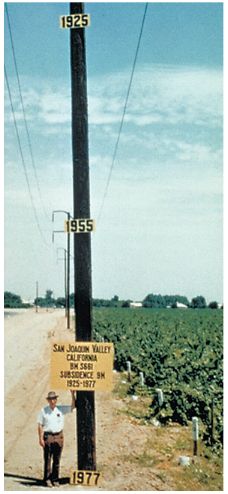EXPLORE: Earth's Water (BrainPop)
Completion requirements
global h2o distibution
6. VIEW: Groundwater Depletion
Natural and human activities can cause groundwater depletion. Groundwater levels can change naturally over time due to changes in weather patterns, precipitation amounts, stream flow, and geologic processes such as erosion. However, the largest contributor to groundwater depletion is pumping from wells. If water is withdrawn from the ground at a faster rate than it is recharged by precipitation, the water table will drop.
There are several negative effects of groundwater depletion:
- Lowering of the Water Table: or water to be pumped from a well, the well must reach below the level of the water table. If the water table is lowered too far it would have economic consequences for well owners. Depending on the characteristics of the rock layer the groundwater is located in, impacts to the water table may be short- or long-term, and the water level may fall only a small amount or hundreds of feet. Excessive pumping can lower the water table so much that wells dry up and can no longer provide water.
- Reduces water in streams & lakes: generally, a large amount of the water flowing into a stream or river comes from groundwater seeping into the riverbed. Pumping groundwater can therefore alter the movement of water between an aquifer and surface water or wetland, influencing aquatic and wetland habitats.
- Land subsidence: as water is removed from rocks and soil, it creates instability and causes the ground to sink. In the United States more, than 17,000 square miles in 45 states have been directly affected by subsidence, most of which is attributed to excessive pumping of groundwater.

Land in the San Joaquin Valley, California dropped 9 meters (29.5 feet) between 1925-1977 as a result of groundwater depletion. Image courtesy of Wikimedia.
Sources: http://ga.water.usgs.gov/edu/watercyclegwstorage.html, http://ga.water.usgs.gov/edu/earthgwlandsubside.htmland http://ga.water.usgs.gov/edu/gwdepletion.html